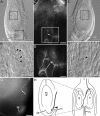Intermittent pollen-tube growth in pistils of alders (Alnus)
- PMID: 15932945
- PMCID: PMC1150840
- DOI: 10.1073/pnas.0503081102
Intermittent pollen-tube growth in pistils of alders (Alnus)
Abstract
In alders, where fertilization occurs approximately 8 weeks after pollination, the pollen tube (male gametophyte) grows intermittently in four steps in close association with the development of the ovary and its ovules. Pollen tubes stop growing in the style, at the ovarian locule, and at the chalaza (ovule), before reaching an embryo sac for fertilization. At the stage when the ovary develops an ovule primordium in each of the two locules, many pollen tubes germinate on the stigma, and a few of them reach the style, where they remain for approximately 7 weeks. Thereafter, a single tube resumes growing; with a short stop in the upper space of the ovarian locule, it reaches the older of the two ovules when it has developed a two-nucleate embryo sac. Except in the last step, where the tube grows from the chalaza to an embryo sac (female gametophyte), an eight-nucleate mature embryo sac is not necessary for pollen-tube guidance in the pistil. Although the intermittent pollen-tube growth appears to play an important role in the selection of a single pollen tube from many and one ovule from two, its detection provides insight into the study of the mechanism of pollen-tube guidance.
Figures




Similar articles
-
Mode of pollen-tube growth in Pistils of Myrica rubra (Myricaceae): a comparison with related families.Ann Bot. 2006 Jan;97(1):71-7. doi: 10.1093/aob/mcj015. Epub 2005 Nov 16. Ann Bot. 2006. PMID: 16291781 Free PMC article.
-
Delayed fertilization and pollen-tube growth in pistils of Fagus japonica (Fagaceae).Am J Bot. 2006 Dec;93(12):1748-56. doi: 10.3732/ajb.93.12.1748. Am J Bot. 2006. PMID: 21642120
-
Pollen-tube growth pattern and chalazogamy in Casuarina equisetifolia (Casuarinaceae).J Plant Res. 2004 Feb;117(1):37-46. doi: 10.1007/s10265-003-0129-z. Epub 2003 Dec 6. J Plant Res. 2004. PMID: 14661077
-
Paving the Way for Fertilization: The Role of the Transmitting Tract.Int J Mol Sci. 2021 Mar 5;22(5):2603. doi: 10.3390/ijms22052603. Int J Mol Sci. 2021. PMID: 33807566 Free PMC article. Review.
-
Pathfinding in angiosperm reproduction: pollen tube guidance by pistils ensures successful double fertilization.Wiley Interdiscip Rev Dev Biol. 2012 Jan-Feb;1(1):96-113. doi: 10.1002/wdev.6. Epub 2011 Nov 18. Wiley Interdiscip Rev Dev Biol. 2012. PMID: 23801670 Review.
Cited by
-
Ovary Signals for Pollen Tube Guidance in Chalazogamous Mangifera indica L.Front Plant Sci. 2021 Feb 10;11:601706. doi: 10.3389/fpls.2020.601706. eCollection 2020. Front Plant Sci. 2021. PMID: 33643328 Free PMC article.
-
Pistillate flower development and pollen tube growth mode during the delayed fertilization stage in Corylus heterophylla Fisch.Plant Reprod. 2014 Sep;27(3):145-52. doi: 10.1007/s00497-014-0248-9. Epub 2014 Jul 30. Plant Reprod. 2014. PMID: 25073757
-
The progamic phase of an early-divergent angiosperm, Annona cherimola (Annonaceae).Ann Bot. 2010 Feb;105(2):221-31. doi: 10.1093/aob/mcp276. Epub 2009 Nov 19. Ann Bot. 2010. PMID: 19939980 Free PMC article.
-
Glycoprotein composition along the pistil of Malus x domestica and the modulation of pollen tube growth.BMC Plant Biol. 2014 Jan 3;14:1. doi: 10.1186/1471-2229-14-1. BMC Plant Biol. 2014. PMID: 24387633 Free PMC article.
-
Links between Regulatory Systems of ROS and Carbohydrates in Reproductive Development.Plants (Basel). 2021 Aug 11;10(8):1652. doi: 10.3390/plants10081652. Plants (Basel). 2021. PMID: 34451697 Free PMC article. Review.
References
-
- Ray, S., Park, S. S. & Ray, A. (1997) Development (Cambridge, U.K.) 124, 2489-2498. - PubMed
-
- Shimizu, K. K. & Okada, K. (2000) Development (Cambridge, U.K.) 127, 4511-4518. - PubMed
-
- Maheshwari, P. (1950) in An Introduction to the Embryology of Angiosperms (McGraw-Hill, New York).
-
- Gao, X., Francis, D., Ormrod, J. C. & Bennett, M. D. (1992) Ann. Bot. 70, 561-568.
Publication types
MeSH terms
LinkOut - more resources
Full Text Sources
Molecular Biology Databases

